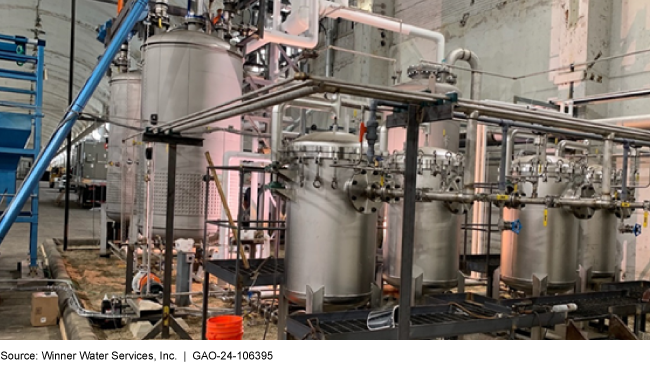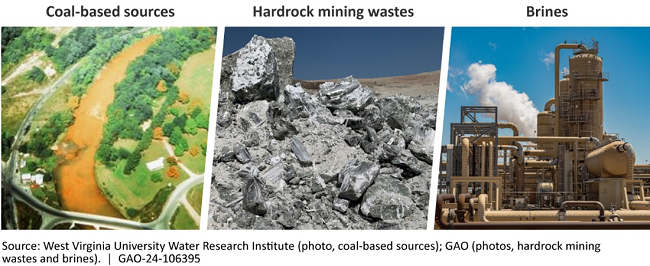Critical Minerals: Status, Challenges, and Policy Options for Recovery from Nontraditional Sources
Fast Facts
Critical minerals like lithium and cobalt feed technologies that keep the U.S. economy running. But other countries control much of the supply.
One way to increase the U.S. supply of critical minerals is to recover them from nontraditional sources. For example, companies can extract minerals from piles of waste rock left at old mines.
But using these sources poses challenges, such as high costs and concerns about being held liable for environmental damage by the original miners.
In this Technology Assessment, we present options—such as financial incentives and liability protections—that policymakers could consider to address challenges.
A small-scale facility in Pennsylvania built to extract critical minerals from coal plant waste

Highlights
What GAO Found
The U.S. is highly dependent on foreign countries, including some adversaries, for its supply of critical minerals for manufacturing, such as rare earth elements for weapons systems and lithium for electric vehicle batteries. In addition to obtaining critical minerals from sources such as hardrock mines, it is possible to produce them from nontraditional sources found across the U.S. Such sources include mining wastes, water from existing mines, waste from coal-fired power plants, and saline groundwater (brine) from geothermal power plants. Domestic, nontraditional sources of minerals could increase the U.S. manufacturing and defense sectors’ independence from foreign suppliers, reducing the need to open new mines, among other benefits.
Nontraditional sources of critical minerals

To recover minerals from coal and mining wastes, operators can generally repurpose mature technologies already used by the mining industry. However, we found that most of these projects are at the pilot scale. In contrast, direct lithium extraction from geothermal brines is closer to commercial-scale operation, with one such plant expected to be operational in 2025.
We identified several areas where challenges may arise in the recovery of critical minerals from nontraditional sources. Recent legislative and executive actions may help address characterization and permitting challenges. Remaining challenges are:
- Liability. Recovery operations on previously mined sites could result in operators being responsible for historical liabilities. There is little appetite in industry to take on this financial risk, according to experts.
- Economics. Due to factors such as high fixed costs and unstable prices potential recovery project operators may be uncertain that their investments will be financially viable.
- Public engagement and tribal consultation. Stakeholders and experts identified engagement with local communities, and when appropriate, government-to-government consultation with Tribal Nations as important steps to a successful critical mineral recovery project.
GAO identified three policy options that could help address the challenges or enhance the benefits of recovering critical minerals from nontraditional sources. The policy options are possible actions by policymakers—which may include Congress; federal agencies; and state, local, and tribal governments. In addition, policymakers could choose to maintain the status quo, whereby they would not take additional action beyond current efforts. See below for details of the policy options.
Policy Options to Help Address Challenges or Enhance Benefits of Recovering Critical Minerals from Nontraditional Sources
| Policy Option | Opportunities | Considerations |
|---|---|---|
| Pilot Good Samaritan legislation (report p. 30) Implementation approaches: Legislators could provide some liability protections for third parties recovering critical minerals from waste at previously mined sites. Legislators could provide protections for third parties but require a portion of profits generated be used for restoration activities. |
|
|
| Subsidies (report p. 30) Implementation approaches: The federal government could subsidize the development of specific nontraditional sources to meet defense or energy needs. Subsidies could be made available as tax credits for those pursuing nontraditional sources of critical minerals. |
|
|
| Community benefit agreements (report p. 31) Implementation approaches: To improve engagement with communities near nontraditional sources, permitting agencies could encourage operators to pursue agreements that outline how communities may benefit from projects that also incur costs in their communities. Companies could adopt policies that encourage or facilitate these agreements. |
|
|
| Status quo (report p. 31) Implementation approach: Sustain current efforts. |
|
|
Source: GAO. | GAO-24-106395
Why GAO Did This Study
Critical minerals are essential for technologies used across the economy, including in energy, defense, health care, and electronics. But the U.S. supply is highly dependent on foreign countries. One strategy for increasing and diversifying the domestic supply of critical minerals is by recovering them from nontraditional sources.
This technology assessment discusses (1) the benefits of recovering critical minerals from nontraditional sources; (2) the status of available technologies to use on mining wastes, coal wastes, and geothermal and other brines; (3) the challenges of recovery from nontraditional sources; and (4) options policymakers could consider to help address the challenges.
In conducting this assessment, GAO interviewed officials from the federal government, academia, private industry, and nongovernmental organizations; convened a meeting of 15 experts with assistance from the National Academies of Sciences, Engineering, and Medicine; analyzed patent data from the U.S. Patent and Trademark Office; and reviewed relevant laws, government reports, and academic literature. GAO is identifying policy options in this report.
For more information, contact Brian Bothwell at (202) 512-6888 or BothwellB@gao.gov.
